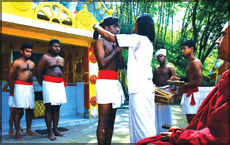Angampora - Sri Lankan martial arts
 'Angampora'
, is this word familiar to you? If you watched 'Dandubasnamanaya' or
'Akala Sandya' on TV, you are sure to have heard it. 'Angampora'
, is this word familiar to you? If you watched 'Dandubasnamanaya' or
'Akala Sandya' on TV, you are sure to have heard it.
Then if you knew about it, you would have wondered why it's not
practised in Sri Lanka any more, and that it has completely died out.
But that is where you are wrong. An angampora 'Kala eli Mangalya,' which
is known as 'Helankada Mangalya,' was staged at Korahathota Raja Maha
Viharaya, Kaduwela recently. Students of Ajantha
|

Helankada Mangalya |
Perera Gurunnanse (master) participated in this event.
The five students included an eight-year-old boy, Dilshan
Kathriarachchi and a nine-year-old girl, Shashikala Abeywickrama
Gunawardene. "They are very talented," Perera said of his
students.According to him, it's for the first time in 160 years that an
event of this nature had been staged in public. Why? Because this
martial art was banned in 1821 by the British rulers, who thought that
those who have excelled in angampora would pose a threat to them.
The Helankada Mangalya was conducted after the first step out of 21
steps, was completed. The students performed with jatavas wrapped around
their foreheads.
According to Perera, this event should be held in a temple.
 Now
let's learn some facts about Angampora. Anga in Sinhala means parts.
Unarmed combat was called angam as only the parts of the human body were
involved in the fight. Combat techniques where various types of weapons
are used are known as Illangam. Now
let's learn some facts about Angampora. Anga in Sinhala means parts.
Unarmed combat was called angam as only the parts of the human body were
involved in the fight. Combat techniques where various types of weapons
are used are known as Illangam.
'This great sport was enjoyed by many of the kings who ruled the
country. Unarmed combat among champions had been the pinnacle of all
events. This art was practised by two main martial arts clans that had
specialised schools to provide the fighters the king and the country
required.
These clans were called Sudaliya and Maruwalliya and heads of these
schools held distinguished office in the king's council. With the British ban, our ancestors who knew the value
of this great martial art, in a last bid to save the knowledge, had
resorted to secretly preserving it within their families.
king's council. With the British ban, our ancestors who knew the value
of this great martial art, in a last bid to save the knowledge, had
resorted to secretly preserving it within their families.
Although part of this knowledge is now lost, aspects of angam kalawa
had fortunately been saved, preventing it from becoming totally lost to
the future generations.
An angampora master selects a student to pass on the knowledge, on
the basis of the good conduct of the student. It is said that it
shouldn't be taught to even one's own child if the required discipline
is not within him/her.
The selected student after lighting lamps to the Buddha and to the
protecting Gods, would have to promise/declare by a statement, that the
art learnt will only be used in his/her defence or in defence of the
family and in the service of the country.
|

Youngest students in action |
History mentions weapons that have been used by the warriors of the
king. Out of these, the sword, bow and arrow, dagger, spear and the
stick were the five main weapons. Since the techniques pertaining to all
these were numerous, it would require a lifetime and dedicated training
for one person to master all weapons.
The most important aspect when learning this art is how you place
your feet. From the beginning to the end, it is said, whatever you learn
will not be of much value if your feet are not in the proper place. As
you progress in learning the art, you will realise the
vulnerability(open to attack) of others who are less knowledgeable of
the weaknesses of their physical capabilities. You will not be angered
by ego-driven petty situations.
You will learn to tolerate others to an extent that you may never
have before, but will also manage to hold your place in society. In
effect, you will become a respected healthy individual who will love and
serve your country, your people and the world.
your people and the world.
The sad part of the story is, the existing 'Angampora' clans are not
accorded any sponsorship by the state to continue this ancient art. The
gurunnanses continue to teach this art to the students in a secretive
manner, as a service, keeping in mind the ban imposed by the Britishers.
Let's hope that these clans will be supported to preserve this art
for many future generations.
Janani Amarasekara |
